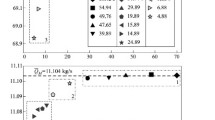Abstract
In an automatic combination weigher, the line feeders distribute the product to several weighing hoppers. The ability to supply appropriate amount of product to the weighing hoppers for each combination operation is crucial for the overall performance. Determining the right duration of operating a line feeder to supply a given amount of product becomes very challenging in case of products which are irregular in volume or specific gravity such as granular secondary processed foods. In this research, several schemes were investigated to determine the best way for a line feeder to approximate the next operating time in order to supply a set amount of irregular goods to the corresponding weighing hopper. Results obtained show that a weighted least squares method (WLS) employing 10 data points is the most effective in determining the operating times of line feeders.
Similar content being viewed by others
References
Han, I. and Lee, Y., 2002, “Chaotic Dynamics of Repeated Impacts in Vibratory Bowl Feeders,”Journal of Sound and Vibration, Vol. 249, No. 3, pp. 529–541.
Helsel, D. R. and Hirsch, R. M., 1992,Statistical Methods in Water Resources, Elsevier, Amsterdam.
Hongler, M. O. and Figour, J., 1989, “Periodic Versus Chaotic Dynamics in Vibratory Feeders,”Helvetica Physica Acta, Vol. 62, pp. 68–81.
Lee, T. T. and Jeng, J. T., 1997, “Chebyshev Polynomials-Based (CPB) Unified Model Neural Networks for Function Approximation,”International Society for Optical Engineering, pp. 372–381.
Lim, G. H., 1997, “On the Conveying Velocity of a Vibratory Feeder,”Computers and Structures, Vol. 62, pp. 197–203.
Meyer, B. and Tischer, P., 2001, “Glicbawls-Grey Level Image Compression by Adaptive Weighted Least Squares,” inProc. IEEE Data Compression Conference, Snowbird, Utah, pp. 503.
Ryan, T.P., 1997,Modern Regression Methods, Wiley, New York.
Strang, G., 1986,Introduction to Applied Mathematics, Wellesley-Cambridge Press.
Winkler, G., 1978, “Analysing the Vibrating Conveyor,”International Journal of Mechanical Sciences, Vol. 20, pp. 561–570.
Winkler, G., 1979, “Analysing the Hopping Conveyor,”International Journal of Mechanical Sciences, Vol. 21, pp. 651–658.
Author information
Authors and Affiliations
Corresponding author
Rights and permissions
About this article
Cite this article
Keraita, J.N., Kim, KH. A study on the optimum scheme for determination of operation time of line feeders in automatic combination weighers. J Mech Sci Technol 20, 1567–1575 (2006). https://doi.org/10.1007/BF02916261
Received:
Revised:
Issue Date:
DOI: https://doi.org/10.1007/BF02916261




